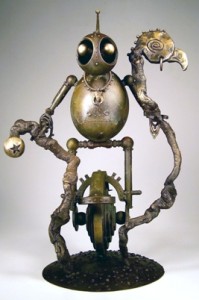
“The Inquisitive Nomad,” Vincent Villafranca, 2011. Bronze sculpture currently on view in the Norman Rockwell Museum exhibition “Robot Nation” (Photo courtesy of Vincent Villafranca. All rights reserved.)
(STOCKBRIDGE, Mass.) — The early Industrial Revolution dances with modern technology in the Steampunk movement, the topic of an illustrated lecture and discussion at the Norman Rockwell Museum on Thursday, August 4, starting at 5:30 p.m. Steampunk Night features Bruce Rosenbaum of ModVic Steampuffin and Ellen Hagney, executive director of the Charles River Museum of Innovation and Industry, discussing the Steampunk movement, a unique sub-genre of science fiction and alternate history in which futuristic appliances and interior designs are based on a neo-Victorian style and perspective. The evening talk is presented as part of the museum’s “Blue Sky & Beyond” summer program series, held in conjunction with the new exhibition ‘Ice Age’ to the Digital Age: The 3D Animation Art of Blue Sky Studios.
A cross-genre movement of literature, visual arts, fashion, and music, Steampunk nods to Victorian and Edwardian Britain, eras when steam power was still widely used, and typically incorporates elements of science fiction or fantasy. Works of steampunk often feature anachronistic technology or futuristic innovations as Victorians may have envisioned them; based on a Victorian perspective on fashion, culture, architectural style, art, etc.
Inspired by fictional machines such as those found in the works of H. G. Wells and Jules Verne, perhaps the most well known example of Steampunk is Captain Nemo’s Nautilus submarine in Walt Disney’s 1954 film version of Jules Verne’s 20,000 Leagues Under the Sea. Various modern utilitarian objects have been modified by enthusiasts into a pseudo-Victorian mechanical Steampunk style. Examples of such objects include computer keyboards and electric guitars. The goal of such redesigns is to employ appropriate materials (such as polished brass, iron, wood, and leather) with design elements and craftsmanship consistent with the Victorian era.
From October 2009 through February 2010, the Museum of the History of Science, Oxford, hosted the first major exhibition of Steampunk art objects, curated by Art Donovan and presented by Dr. Jim Bennett, museum director. From redesigned practical items to fantastical contraptions, this exhibition showcased the work of eighteen Steampunk artists from across the globe. The exhibition proved to be the most successful in the museum’s history and attracted more than eighty thousand visitors.
The Norman Rockwell event is free for museum members or with regular museum admission.
